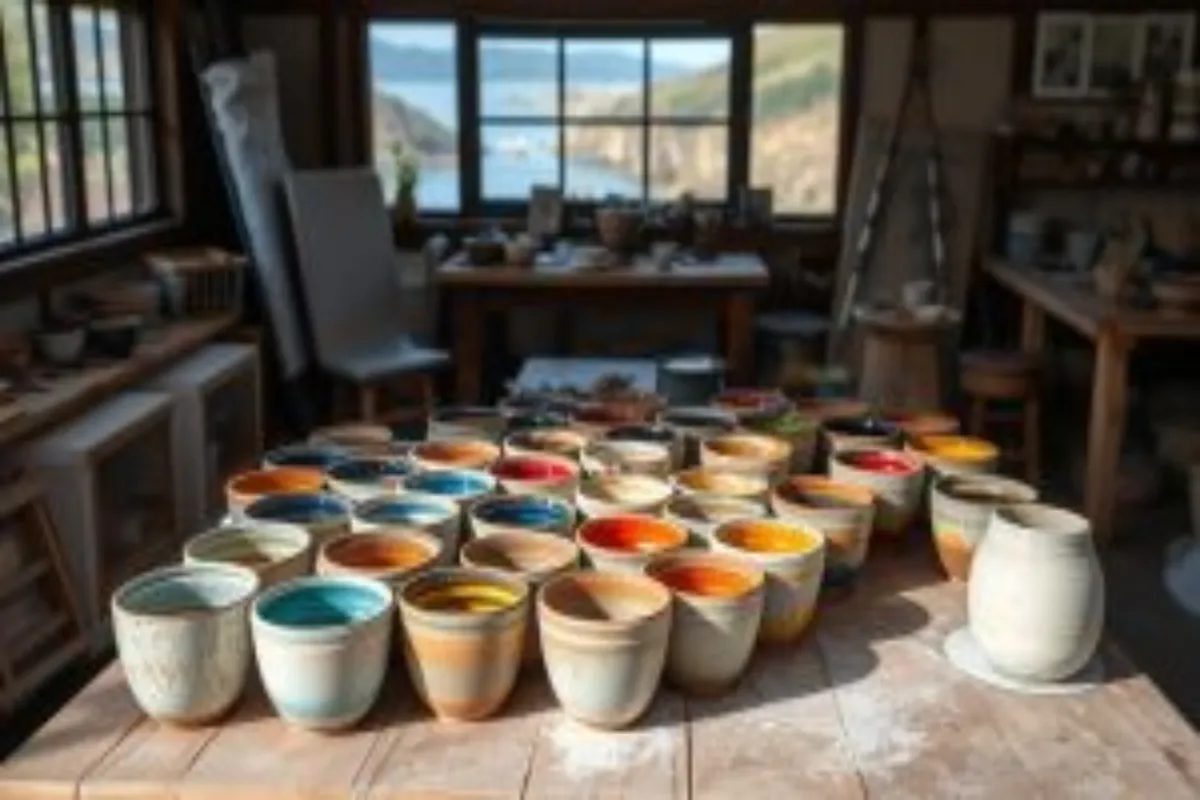The Cornwall Stone Glaze Recipe is key to traditional pottery. It’s known for its unique look and feel. This guide is for potters at every level. It covers the glaze’s history, ingredients, and how to apply it. Potters will learn to make pieces that capture Cornwall’s essence.
Key Takeaways
- Learn the significance of the Cornwall Stone Glaze Recipe in pottery.
- Discover traditional pottery techniques that enhance the glazing process.
- Explore the essential ingredients required for creating this unique glaze.
- Understand the application methods for achieving stunning results.
- Gain insights into troubleshooting common glazing issues.
- Connect with the pottery community for support and resources.
Introduction to Cornwall Stone Glaze
The Cornwall stone glaze is known for its amazing qualities in pottery. Potters love it for its beauty and usefulness. It makes their work look great and last long, working well with many types of clay.
The strong points of the Cornwall stone glaze are:
- Durability: It can handle a lot of use and handling.
- Color: There are many colors to choose from, giving artists a lot of freedom.
- Texture: The finish can be smooth or rough, fitting different pottery styles.
This glaze is a top choice for potters who want their pieces to be both useful and beautiful.
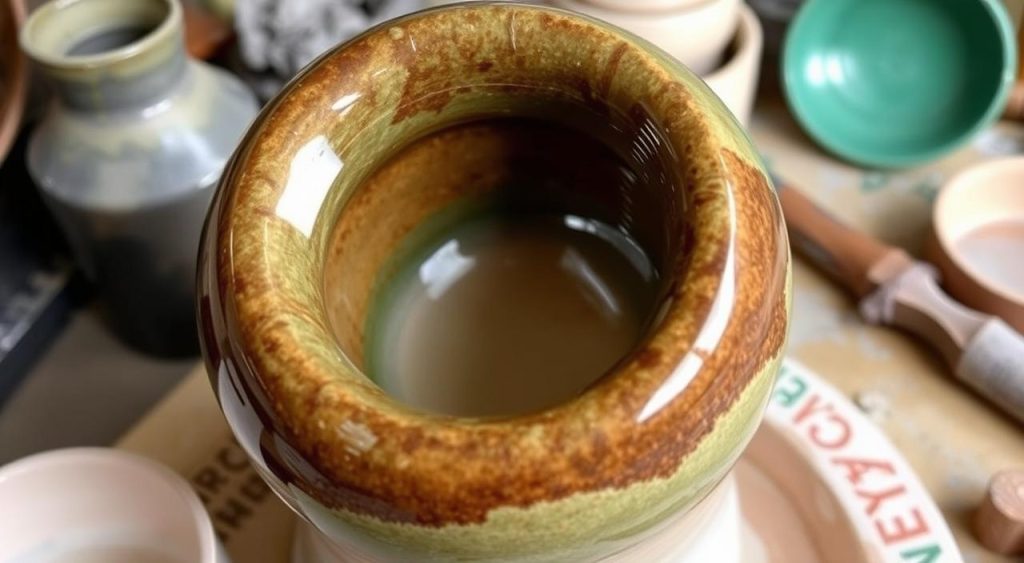
The History of Stone Glazing in Cornwall
The history of cornwall stone glaze shows a deep link between local traditions and pottery evolution. Cornwall’s natural resources were key in developing glazing techniques. Artisans have honed these methods over many years.
At first, local potters used the area’s rich materials. They found certain minerals that gave them unique glazes. This led to a distinct style for their pottery. As time went on, new techniques and styles emerged, marking big leaps in stone glazing.
Over the years, Cornwall has seen many skilled artisans. Their work and experiments have led to bright glazes that mix tradition with new ideas. This blend of old and new makes stone glaze in Cornwall’s pottery scene still popular today.
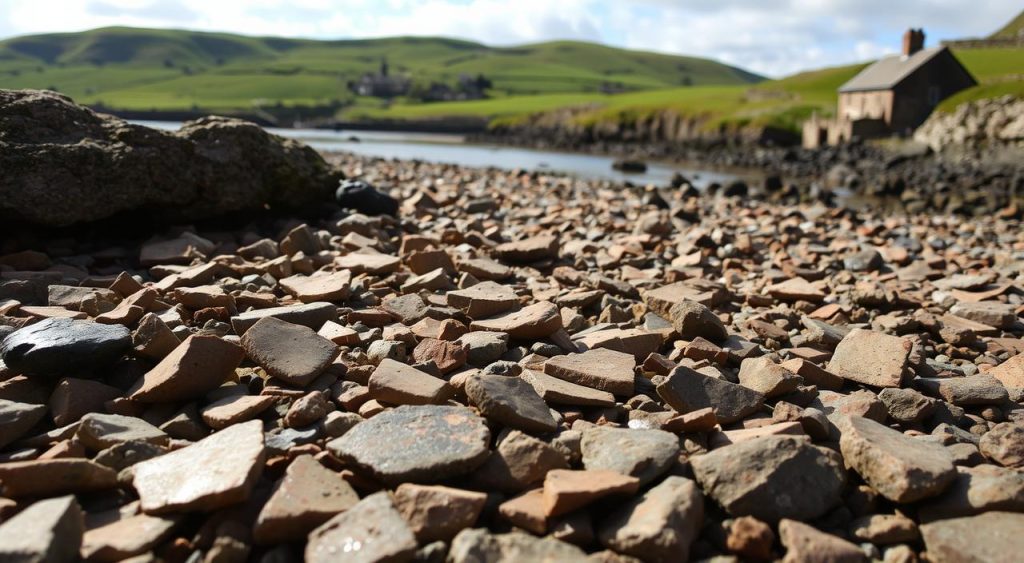
Understanding the Ingredients
Making a great Cornwall stone glaze means knowing the glaze ingredients well. Each part of the mix has its own job, affecting the pottery’s finish and feel. Learning about the Cornwall stone glaze components helps make beautiful pieces that last longer.
Essential Components for the Recipe
The main glaze ingredients for Cornwall stone glaze are:
- Feldspar: It makes the mixture melt at lower temperatures.
- Kaolin: This adds flexibility and keeps the glaze stable.
- Silicate materials: They help shape the glaze’s texture and look.
Knowing how these pottery materials work together is key. It helps make a glaze that does well in the firing process.
Ingredient Sourcing Tips
It’s important to find top-quality ingredients for pottery. When looking for your Cornwall stone glaze ingredients, think about:
- Buying from local suppliers for freshness and less environmental harm.
- Looking online for a variety of glaze materials.
- Checking the supplier’s reputation and reviews for quality.
Choosing sustainable options can also help potters connect with their community. For more tips on finding pottery ingredients, see this guide.
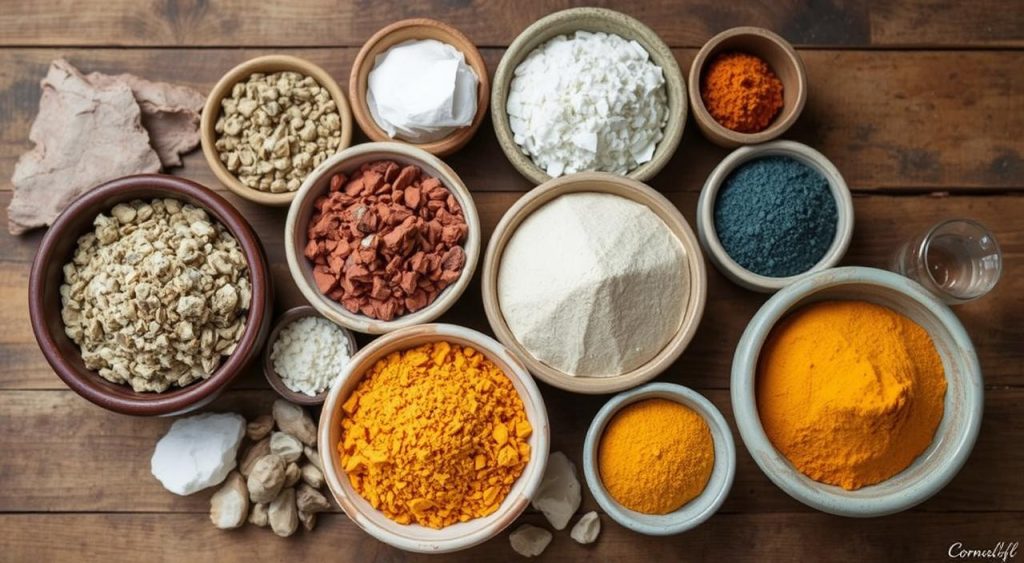
Step-by-Step Cornwall Stone Glaze Recipe
Making a perfect Cornwall stone glaze takes careful steps. By following these steps, potters can get consistent results that make their work stand out. This part will cover the key techniques for preparing and mixing glaze.
Preparation and Mixing Techniques
Mixing glaze needs focus on details. Start by collecting your glaze ingredients, a scale for accurate measurements, and big mixing containers. Here’s what to do next:
- Measure each part as the recipe says.
- Blend dry ingredients well before adding liquids.
- Add water slowly while mixing to get a smooth, even mix.
- Let the mix rest for a bit to let bubbles out.
- Check the glaze’s thickness, add water if needed to get the right feel.
These steps are key to making sure the glaze sticks well when you apply it.
Application Methods for Pottery
Getting the glaze on right is key for the look you want. Learn different pottery glaze techniques to pick the best one for your piece’s shape and size. Here are some top ways to apply:
- Dipping: Great for small items; dip them fully for an even coat.
- Brushing: Best for big pieces, lets you control the design and coverage.
- Spraying: Excellent for a thin mist and detailed layering.
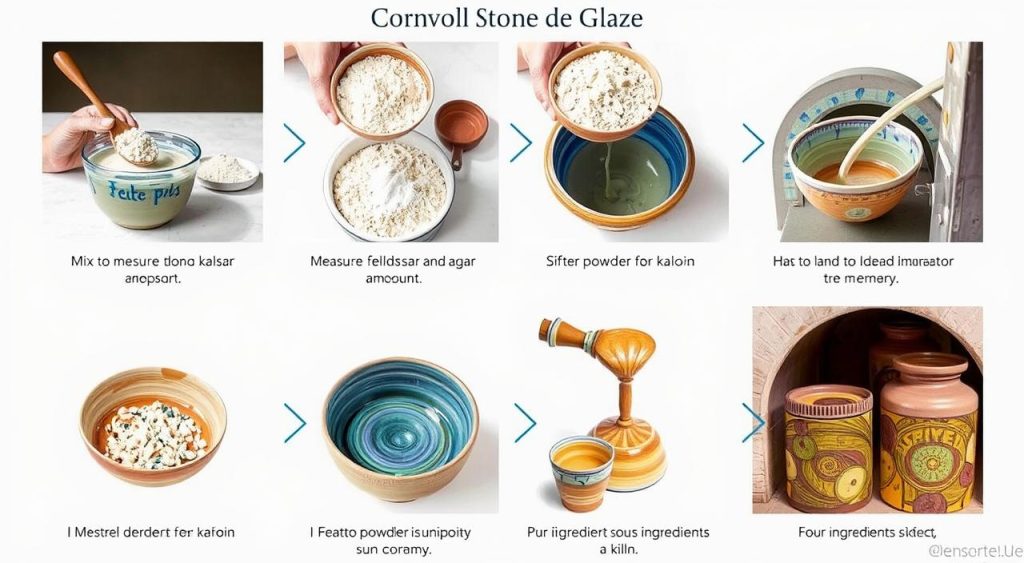
Importance of Firing Techniques
Learning how to fire pottery right is key to getting the look and durability you want. The firing process changes the glaze’s color, texture, and finish. Important things to consider include:
- Temperature Control: Keeping the kiln at a steady temperature is crucial for glaze firing. If the temperature changes, the glaze might not color right or melt fully.
- Kiln Atmosphere: The air inside the kiln, whether it’s full of oxygen or not, affects how the glaze reacts. This changes the glaze’s color and how clear it is.
- Firing Schedules: How long you fire the pottery and the order you do things in matters a lot. Giving the glaze enough time at certain temperatures helps it stick and look its best.
Using the best firing methods for pottery helps avoid mistakes and gets you the results you want. Knowing how these parts work together makes creating pottery more fun and rewarding. This way, your finished pieces will look just how you imagined them.
Testing Your Glaze for Quality
To get the best glaze quality, it’s key to test it carefully. The test firing process helps potters see how their glaze acts under certain conditions. Knowing these results is vital for controlling glaze quality.
How to Conduct a Test Fire
Start by making small test tiles for your glaze. These should be the same size and clay type as your pottery. Here’s how to test fire them:
- Apply the glaze evenly on the test tiles.
- Let the glaze dry completely.
- Put the tiles in the kiln, making sure they’re not touching each other.
- Set the kiln to the firing temperature you want and schedule it right.
Interpreting the Results
Once the test firing is done, it’s time to check the glaze. Look for things like:
- Gloss levels: Is the glaze too shiny or not shiny enough?
- Color consistency: Are there any color changes you didn’t expect?
- Surface texture: Does the glaze have any lumps or flaws?
This check-up helps you make changes to the glaze. It makes your pottery better and more pleasing.
Common Issues with Cornwall Stone Glaze
Working with Cornwall Stone Glaze can bring challenges to pottery makers. Spotting these issues early helps find solutions that improve your work. This part talks about common problems like uneven gloss, texture issues, and color changes during firing.
Fixing Gloss and Texture Problems
Potters often face problems with uneven gloss and textures. Here are some tips to fix these glaze issues:
- Adjust the application thickness. Too thick can cause unwanted glossiness, while too thin might make it matte.
- Try different application methods. Brushing, dipping, or spraying can change the texture.
- Make small changes to firing schedules. This can affect the glaze’s surface finish.
Dealing with Color Variations
Color changes in glaze can be a big problem, especially if you want specific colors. Many things can cause these changes during firing. Here are some ways to fix these issues:
- Check the quality of your raw materials. Dirty ingredients can make the color inconsistent.
- Look at where you place your kiln. The heat flow can change the glaze color.
- Do small test batches before firing more pieces. This helps spot color problems early.
Tips for Perfecting Your Glaze Application
Getting a perfect glaze finish takes skill in pottery application techniques. Preparing well and applying glaze correctly can make your work look amazing. Here are some glaze application tips to help you improve:
- Surface Preparation: Make sure your pottery is clean and dust-free. A good wash and scrub prepare the surface for glaze.
- Application Thickness: It’s key to apply glaze evenly for the best look. Use a thick layer for bright colors, but don’t let it pool.
- Testing Techniques: Try different ways to apply glaze like dipping, pouring, or brushing. Each method creates unique effects, so test them on small pieces first.
- Control Environment: Glaze application is affected by humidity and temperature. Working in a controlled space helps you get consistent results.
Benefits of Using Cornwall Stone Glaze Recipe
The Cornwall stone glaze does more than make pottery look good. It also makes it last longer. Potters love how it makes their pieces strong against scratches and chips.
Glaze benefits include sticking better to the clay. This means the pottery looks smoother and has deeper colors. It makes ceramics more beautiful.
Using Cornwall stone glaze improves pottery quality. It gives a unique look that’s both tough and attractive. Potters enjoy the process and feel proud of their work.
Showcasing Your Pottery
Displaying pottery the right way can make it look more appealing. Using good presentation helps show off the beauty of the glazes. It makes people notice the details of each piece. Here are some tips for showing off your pottery with the best lighting, arrangement, and materials.
Best Display Methods for Glazed Works
To make your ceramics look great, try these display tips:
- Use natural light: Put the pieces near windows to use sunlight. This makes the glazes look more vibrant.
- Sturdy bases: Use shelves or pedestals that match the pieces and hold them safely.
- Group arrangements: Put items together in groups for more interest. Mix heights for a good look.
- Backdrops: Choose simple backgrounds that don’t take away from the pottery. Let the pottery be the main focus.
Participating in Local Pottery Shows
Being in local pottery shows can get you noticed. It helps you connect with the community. Here are some tips for a successful show:
- Preparation: Pick pieces that show off your style and your work’s variety.
- Presentation: Make sure your display looks professional. Include signs and promotional stuff.
- Networking: Use these events to meet other artists and fans. Share ideas and techniques to help everyone.
Showing off your pottery well can make people appreciate your art more. It also builds a supportive community in the pottery world.
Community and Resources for Potters
Connecting with other potters helps us grow and get inspired. Many online forums and communities share tips and experiences. They talk about everything from glazes to kilns, offering great online ceramics support for all.
Online Forums and Support Groups
Being part of pottery forums makes us feel like we belong. It also helps us work together. Here are some top places to join:
- Ceramic Arts Daily
- Pottery Heads
- Facebook Groups dedicated to pottery
These groups often show off members’ work and give advice. If you need help with a technique or have questions, these pottery forums are a great place to start.
Workshops and Classes in the U.S.
Learning new things is key to getting better at pottery. The U.S. has many workshops and classes for all levels. Here are some top spots:
- The Clay Studio in Philadelphia
- Pisgah Forest Pottery in North Carolina
- Penland School of Craft in North Carolina
These workshops help improve your skills and let you meet other potters. Many focus on glazes and techniques, giving you the knowledge you need. Look for local workshops to deepen your craft.
Cornwall Stone Glaze Recipe Unleashed
For potters eager to grow, advanced cornwall stone glaze techniques offer a thrilling journey. This part explores complex versions of the Cornwall stone glaze recipe. It lets skilled artists dive into their creativity.
Trying out different firing temperatures is a great way to innovate. Each temperature can create unique surface effects. Consider these options:
- Low-temperature firings for softer and more muted finishes
- Mid-temperature firings to achieve vibrant colors and textures
- High-temperature firings for a glass-like sheen
Adding special ingredients can also lead to interesting results. For example, adding copper carbonate or iron oxide can change the glaze’s look. These creative moves boost your glazing skills, making your pieces truly unique.
Layering glazes is another creative method. Potters can put on several coats of different glazes to see what happens. This can create stunning depth and complexity in your work.
It’s important to apply glaze consistently during the process. Trying brush, spray, or dipping techniques can give you various effects. This helps improve your glazing skills.
Sharing your work with other potters is a great idea. Joining local pottery groups can spark new ideas and build a supportive community. This sharing can help refine your glazing techniques, turning pottery into a true passion.
Conclusion
The Cornwall stone glaze recipe is a timeless way for potters to improve their skills. This article covered the key ingredients and how to apply them. It shows how to make pieces that mix tradition with creativity, a key pottery takeaway for today’s ceramic artists.
Thinking about the Cornwall stone glaze, we see it helps potters understand materials and beauty better. It’s great for both experienced and new potters. The key is to test, be patient, and try new things to get the look you want.
Using this glaze links potters to a long tradition and encourages new ideas in their work. For more inspiration, check out this guide on a tasty recipe here. Learning about the Cornwall stone glaze is a journey of discovery and self-expression.
FAQ
What is the Cornwall stone glaze recipe?
The Cornwall stone glaze recipe is a special mix used by potters. It makes pottery pieces look unique and last a long time. The mix includes feldspar, kaolin, and silicate materials.
How can I source ingredients for the Cornwall stone glaze?
You can get ingredients for the Cornwall stone glaze from trusted suppliers. Look for them online or in your area. Choose high-quality materials and support the pottery community by being sustainable.
Can you provide tips on mixing the Cornwall stone glaze?
Yes, mixing the Cornwall stone glaze needs careful measurements and the right mixing methods. Follow a step-by-step guide to get consistent results. Use the right tools and keep the mixing ratios correct.
What are some effective glaze application methods?
You can apply glaze by dipping, brushing, or spraying. The best method depends on the pottery’s shape and size. Make sure to apply the glaze evenly for the look you want.
Why are firing techniques important for pottery glaze?
Firing techniques are key because they affect the glaze’s look and strength. You need to control the temperature and kiln conditions well. This ensures the glaze turns out right.
How do I test my glaze for quality?
Test firing your glaze to see how it behaves. This helps you adjust the recipe for better results. It ensures your final pieces are top quality.
What are common issues with Cornwall stone glaze?
Issues like uneven shine and color changes can happen. Fix these by tweaking the glaze recipe or how you apply it. This helps get a consistent look.
What are some tips for enhancing glaze application techniques?
Improve your glaze finishes by focusing on details and preparation. Know the right glaze thickness and try different techniques. This will give you better results.
What benefits does the Cornwall stone glaze offer?
The Cornwall stone glaze makes pottery more durable and beautiful. It connects to traditional pottery methods. This glaze can make pottery last longer and look better.
How should I display my glazed pottery?
Display glazed pottery well by arranging it carefully and using the right lighting. Choose materials that match the pottery. This shows off the glaze’s beauty.
Where can I find pottery workshops and classes in the U.S.?
Look for pottery workshops and classes at local studios, community centers, and art schools in the U.S. These are great for improving your pottery skills and craft.
What are some online resources for potters?
Potters can find online forums, social media groups, and ceramics websites. These offer tips, advice, and support from other pottery lovers.
What advanced techniques can be used with the Cornwall stone glaze?
Skilled potters can try new techniques and variations with the Cornwall stone glaze. This leads to unique pottery pieces. It’s a way to innovate your work.

